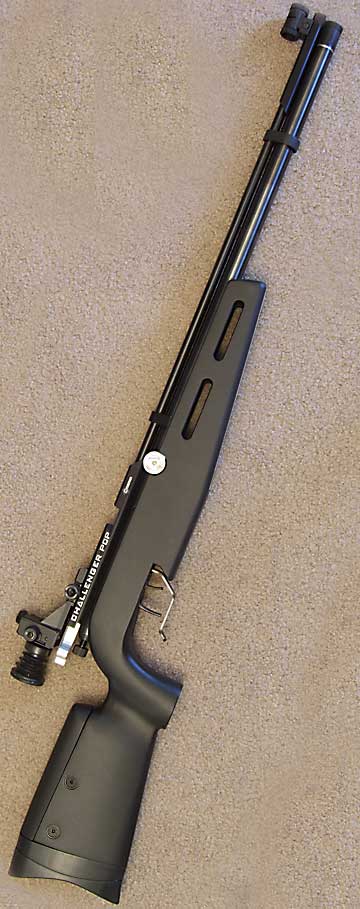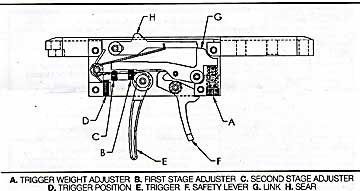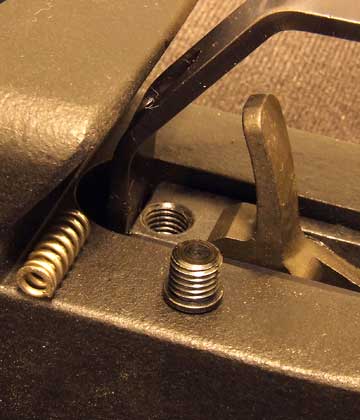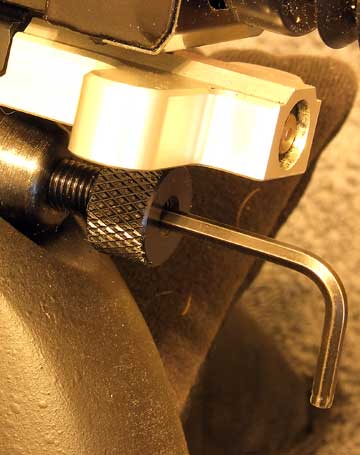by B.B. Pelletier
Happy Thanksgiving to all our U.S. readers, wherever they may be.
Blogger is still hosed, but Edith is finding ways around it. The Blogger support team, in contrast, hasn’t done anything to solve the issue, which affects not just this blog but also many others around the world. Edith has been in touch with people from all over, and they’re sharing tips on workarounds.

Crosman Challenger 2009 target rifle has awakened a large segment of shooters!
I mentioned in Part 4 that I would return and adjust the rifle for a specific pellet. And in Part 3 I mentioned that my test shot string of 100 shots had a 34 f.p.s. deviation. That’s important to remember, as today I’m going to try to stretch that just a bit.
Trigger adjustment
Before I get to the velocity adjustment, though, I first want to cover the trigger. Back when I did the Benjamin Marauder test, I didn’t adjust the trigger because it was already so good from the factory. But the Challenger 2009 is a target rifle, and it’s pretty important to have the trigger adjusted well on a target rifle.
There are four adjustments on this trigger. They are the location of the trigger blade, first-stage travel, second-stage travel and the weight of the trigger-pull. When adjusting the first stage travel you affect the second-stage travel as well, so adjust those two together.

Crosman Challenger 2009 trigger is very adjustable.

When I adjusted the trigger-pull weight, the screw fell out of its hole, along with the spring that controls the pull weight. The trigger still had a legal amount of pull.
Velocity adjustment
You can adjust the length of the hammer stroke and the tension on the hammer. The shorter the stroke, the less air that escapes and vice-versa. The greater the tension on the hammer spring, the harder the hammer hits the valve and the more air that escapes. And vice-versa!

The knurled knob adjusts the hammer spring tension. Long Allen wrench adjusts the length of the hammer stroke.
What do you want to do?
I wanted to increase the number of usable shots by decreasing the average velocity. But how much did I have to drop to get a good long string with the least velocity variation?
The manual gives guidance for default settings of both adjustments, but that doesn’t answer my question. And nobody can answer my question, because these are two interrelated but separate adjustments that affect one another. You may adjust either one or both adjustments and get an initial velocity change, but how do you know if that change is what you really want? There’s only one way to know. You have to shoot the gun from a fresh fill until it drops in velocity below your minimum criterion. And YOU have to pick that criterion! If you’re reading this report the way I intended, you are now seeing that this process is practically infinite. Yet, getting through it isn’t nearly as cumbersome or confusing as it sounds. You just have to turn off your brain and stop trying to guess what will happen.
Here’s what I did
I decided to adjust both the hammer stroke and the hammer spring tension at the same time. Since I didn’t know what I was doing, I put a full clockwise turn on the hammer stroke screw and a full turn counterclockwise on the hammer spring tension adjuster. I didn’t know what the whole outcome of my adjustments would be. The owner’s manual specified what each adjustment would do, but nothing can tell you what the whole shot string will do. That takes experience.
The challenge
Following a fresh fill to 2,000 psi, I chronographed the first shot from the rifle with H&N Finale Match pellets at 560 f.p.s., which was very close to the average I’d gotten in an earlier test (556 f.p.s.). In that test I had gotten 72 total shots within 18 f.p.s. from Gamo Match pellets, and I guess I also got a 100-shot string that had 34 f.p.s.total spread but I don’t know which pellet that was. But that was what I set out to beat. I wanted to get better than 100 shots in a string, or a 100-shot string with a variation lower than 34 f.p.s.
After the first adjustment (one turn in on the hammer stroke, one turn out on the hammer spring tension) the velocity was 540 f.p.s. I thought that was still too fast, so I adjusted the gun a second time. This time it came out with a shot at 532 f.p.s. That was just a trifle above what I was looking for, so I took it. The test was now underway, and the first two shots were included.
Mind-numbing!
I don’t have the ballistic printer for my Chrony like I told you about yesterday, so when I record any shot string, I have to write all the numbers down. A 100-shot string is mind-numbing, to say the least.
The Challenger 2009 went on and on–far longer than I thought it would. Remember, I was getting 72 shots at 560 f.p.s. before adjustment. How much more would come from dropping the speed by a paltry 28 f.p.s.? I had hoped for over 85 shots when this test began, but the rifle was still pumping them out at shot 100. Finally, shot 117 dropped below my criterion of 29 f.p.s. total spread. So, there were an amazing 116 shots in the string that averaged 545 f.p.s.
How did I select the criterion of 29 f.p.s.? I didn’t. The gun did. After that first slow shot of 528 f.p.s., the velocity started increasing. The increase was slow but inexorable, until, at shot 64, the velocity climbed to 557 f.p.s., which was as high as it would go. At that point, 29 f.p.s. separated the high from the low, so I decided to keep on shooting until the velocity dropped below that of the slowest shot–528. Had the top number been higher, I would have accepted it and had a larger total velocity variation. Can you see that I am not controlling anything at this point? I’m just keeping a record of what’s happening.
If you’re very sharp, you also picked up on the fact that the starting velocity of 528 f.p.s. is not the average of this string. It was actually 545. So, I didn’t actually lower the velocity of the gun by 28 f.p.s., as I said earlier. I lowered it by just 15 f.p.s. And that was all it took to increase the shot string from 100 shots with a 34 f.p.s. variation to 116 shots with a 29 f.p.s. variation. I accomplished both my goals on the first try.
Do you think I could do even better than that? Probably. But I’ll leave that chore to you guys. Each of you wants something different from his gun; and as long as you keep it reasonable, the Challenger 2009 can deliver. Remember, it does all of this on a fill of just 2,000 psi.
I’m currently testing the AirForce Edge, which is within a week or two–at the most–of coming to market. As soon as I know when the gun will be available, I’ll start reporting on it.
HAPPY THANKSGIVING to each of you!
Mr B.
Happy Thanksgiving everybody.
twotalon
Happy Thanksgiving!
Edith
A happy and abundant Thanksgiving to all!!! This blog and all involved,I am very thankful for…Frank B
Anybody shoot their turkey before roasting it for a penetration test in real meat??
twotalon
twotalon,
Yes, I shot our turkey this year with an airgun. AA S410.
Just one shot. Nonetheless, the people in the grocery store looked at me very strange.
kevin
two talon,
I'm a single parent and told my kids that I was making it easier to insert the thermometer. Sure dad:)
Mr B.
Happy Thanksgiving to all.
I see little stacks of miniature pumpkins around to mark the season, and it would be just the thing to pick them off with an airgun, one at a time, without disturbing the ones below.
B.B., always glad to hear about the Challenger and the Challenger/Edge match-up will be one worthy of the holidays. How is that t-shaped bolt working for you? It does look cramped under the rear sight and like it would be difficult to work.
I'm surprised to see that there is a steady increase in velocity in a shot string. I guess I never paid attention to the strings of chrony numbers. I thought you had valve lock, then steady velocity, then decline. The increase in velocity adds undesirable variability, but maybe at 10 meters–especially with the slow rate of increase–it doesn't matter. 100+ shots per fill is a pumper's dream.
Matt61
Hi Kevin,
I've just never understood why people get so excited when you bring a gun into the grocery store. Where do they think all those turkeys come from, anyway?
Anyway, HAPPY TURKEY DAY to all. We've got about 65 people coming here for dinner in about 45 minutes. Time to get back to making the smashed potatoes.
A.F. Edge…..yeah right.
Happy Thanksgiving to Mr and Mrs BB + all the blog readers! 🙂
G.
Happy Thanksgiving!!!!!!
When I shoot my Discovery indoors I adjust down to 10-12 ftlbs and get about 120 shot. Do I have a chrony? No. But the target will tell me if I have chosen the right pellet and velocity. I always keep a journal of what pellets I use, the adjustments I make and the performance outcomes.
B.B,
You've recommended the Bug Buster scope in the past and I was wondering if there's any difference between the UTG and the Leapers Bug Buster?
Thanks,
Buggy
Buggy,
Leapers makes UTG, but which UTG are you referring to, when comparing it to the Bug Buster?
B.B.
Can anyone tell me what was supposed to mount underneath the forestock on my FWB 150?? It has about an 8 in. long recessed dovetail groove designed to recieve an accessory of some sort.The rifle is from the late 60s if that helps and was bought in Germany… Frank B
Frank,
That accessory rail is standard on 10-meter target rifles and is for a hand stop and a sling swivel.
B.B.
Thank you BB for solving my little mystery Frank B
B.B,
Leapers makes a 4x32AO Bug Buster Compact Rifle Scope but UTG also sells another scope with the same specification and even the same model# SCP-432AOMDL2 but a bit cheaper.
Thanks,
Buggy
Will I do damage to my Crosman Challenger and my Benjamin Discovery by filling them to 2300 psi?
Earl,
I just got done reading about sprung gauges due to overpressurization so I would say that’s one area of concern, who knows what else people have had happen and aren’t willing to tell others why? Your Disco should be OK because they’re able to go to 3000 but if I had a Challenger(Nice gun!) I wouldn’t take the risk.
Earl,
The Discovery will just shoot much slower. The Challenger will probably not shoot at all, or it will be very slow until you get that excess air out of the gun.
Both guns have pressure tubes rated to 3,000 psi.
B.B.
Below are my Challenger velocities with shot #1 at 2300 psi.
This Challenger and my Discovery have not been modified.
The Challenger has a “sweet spot” from 2300 to about 1300 psi.
The Discovery has a “sweet spot” from 2500 to about 1600 psi.
The Discovery velocities are on the Discovery site.
I was concerned about filling them to more than 2000 psi but they seem to work best starting at 2300 and 2500 psi. The psi readings are from the Benjamin pump gauge which seems to be correct.
The accuracy is excellent. The Challenger groups are too small for me to measure at my 54 feet inside range.
What do you think about this?
Crosman Challenger on 2-17-2015
Model CH2009 .177 cal.
Knob=0.164″, wrench=2 turns in from stop
JSB RS 7.33 gr pellets
Shot FPS
1 626 3 —-pump=2300
2 629 3 0 gun in white 1mm
3 630 1 -1
4 633 3 -4
5 629 -4 0
6 632 3 -3
7 629 -3 0
8 629 0 0
9 631 2 -2
10 626 -5 3 high end of red
11 630 4 -1
12 630 0 -1
13 629 -1 0
14 627 -2 2
15 628 1 1
16 627 -1 2
17 628 1 1
18 625 -3 4
19 626 1 3
20 627 1 2 low end of red
21 626 -1 3
22 625 -1 4
23 623 -2 6
24 624 1 5
25 623 -1 6
26 628 5 1
27 621 -7 8
28 622 1 7
29 622 0 7
30 623 1 6 —gun=2000
31 623 0 6 1-30=10 psi/shot
32 621 -2 8
33 620 -1 9
34 620 0 9
35 619 -1 10
36 617 -2 12
37 614 -3 15
38 617 3 12
39 617 0 12
40 617 0 12
41 617 0 12
42 614 -3 15
43 621 7 8
44 614 -7 15 oil bolt & O-ring
45 622 8 7
46 620 -2 9
47 621 1 8
48 621 0 8
49 622 1 7 average 1-50
50 619 -3 10 624
51 620 1 9
52 618 -2 11
53 614 -4 15
54 616 2 13
55 615 -1 14
56 611 -4 18
57 617 6 12
58 616 -1 13
59 615 -1 14
60 610 -5 19
61 609 -1 20
62 612 3 17
63 611 -1 18
64 612 1 17
65 608 -4 21
66 609 1 20
67 609 0 20
68 605 -4 24
69 607 2 22
70 608 1 21
71 605 -3 24
72 605 0 24
73 602 -3 27
74 600 -2 29
75 598 -2 31 about 1400 psi
76 597 -1 32
77 594 -3 35
78 597 3 32 618
79 593 -4 36 average 1-78
80 592 -1 37
81 594 2 35
82 588 -6 41
83 591 3 38
84 586 -5 43
85 586 0 43
86 582 -4 47 about 1300 psi
87 581 -1 48
88 579 -2 50
89 579 0 50
90 578 -1 51
91 572 -6 57
92 571 -1 58
93 566 -5 63
94 565 -1 64
95 565 0 64
96 563 -2 66
97 558 -5 71
98 556 -2 73
99 553 -3 76
100 553 0 76
101 550 -3 79
102 545 -5 84
103 546 1 83
104 542 -4 87
105 540 -2 89 —gun=1000 psi
106 536 -4 93 105 shots 2300-1000
107 533 -3 96 =12.4 psi/shot
108 531 -2 98
109 526 -5 103
110 524 -2 105
111 521 -3 108
112 515 -6 114
113 515 0 114
114 509 -6 120
115 506 -3 123
116 502 -4 127
117 496 -6 133
118 494 -2 135
119 485 -9 144
120 481 -4 148
121 479 -2 150
122 473 -6 156
123 468 -5 161
124 464 -4 165
125 456 -8 173
126 454 -2 175
127 446 -8 183 bottom of green
Please use this corrected post to the above.
I copied too many numbers from my spreadsheet.
The extra numbers in the above post are
1. the drop in fps from the previous shot
2. the difference from the average of 629 fps.
Crosman Challenger on 2-17-2015
Model CH2009 .177 cal.
Knob=0.164, wrench=2 turns in from stop
JSB RS 7.33 gr pellets
Shot FPS
1 626 —-pump=2300
2 629 gun in white 1mm
3 630
4 633
5 629
6 632
7 629
8 629
9 631
10 626 high end of red
11 630
12 630
13 629
14 627
15 628
16 627
17 628
18 625
19 626
20 627 low end of red
21 626
22 625
23 623
24 624
25 623
26 628
27 621
28 622
29 622
30 623 —gun=2000
31 623 1-30=10 psi/shot
32 621
33 620
34 620
35 619
36 617
37 614
38 617
39 617
40 617
41 617
42 614
43 621
44 614 oil bolt & O-ring
45 622
46 620
47 621
48 621
49 622 average 1-50
50 619 624
51 620
52 618
53 614
54 616
55 615
56 611
57 617
58 616
59 615
60 610
61 609
62 612
63 611
64 612
65 608
66 609
67 609
68 605
69 607
70 608
71 605
72 605
73 602
74 600
75 598 about 1400 psi
76 597
77 594
78 597 618
79 593 average 1-78
80 592
81 594
82 588
83 591
84 586
85 586
86 582 about 1300 psi
87 581
88 579
89 579
90 578
91 572
92 571
93 566
94 565
95 565
96 563
97 558
98 556
99 553
100 553
101 550
102 545
103 546
104 542
105 540 —gun=1000 psi
106 536 105 shots 2300-1000
107 533 =12.4 psi/shot
108 531
109 526
110 524
111 521
112 515
113 515
114 509
115 506
116 502
117 496
118 494
119 485
120 481
121 479
122 473
123 468
124 464
125 456
126 454
127 446 bottom of green